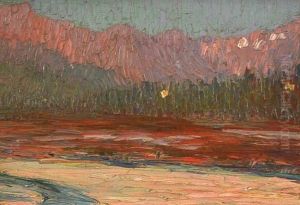Archimede Santi Paintings
Archimede Santi was an Italian painter and architect born in Urbino, Italy, in 1821. His contributions to art, particularly within the realm of painting, were notably influenced by the rich cultural heritage of Italy, a country renowned for its monumental contributions to the world of art through the centuries. Santi's work, although not as widely recognized as that of some of his contemporaries, provides a fascinating glimpse into the Italian art scene of the 19th century, especially within the context of the Romantic and early Realist movements that were prevalent during his lifetime. Santi's education in art and architecture was deeply rooted in the traditions of the Italian Renaissance, yet he managed to infuse his work with a sense of contemporary relevance. His paintings often reflected the landscapes and daily life of his native Italy, capturing the beauty and simplicity of rural scenes with a remarkable attention to detail and a profound sense of emotion. In addition to landscapes, Santi also explored historical and religious themes, demonstrating his versatility and depth as an artist. Despite his talents, Santi remained relatively obscure outside of Italy, with only a modest following during his lifetime. Throughout his career, Santi also engaged in architectural projects, although this aspect of his work is less documented and celebrated than his paintings. His architectural contributions, however, underscore his comprehensive understanding of art as a multi-dimensional field that encompasses both the creation of visual beauty and the practical aspects of designing spaces. Santi's death in Urbino in 1880 marked the end of a career that, while not as publicly lauded as some of his peers, was nonetheless significant for its contribution to the Italian art landscape of the 19th century. Today, Santi's work is appreciated by art historians and collectors who recognize the importance of his contributions to the broader narrative of Italian art.

